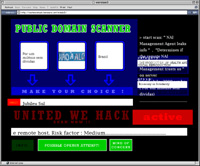|
|
|
posted by
curators
on Thursday April 25, @04:56PM
|
Knowbotic Research. Minds of Concern::Breaking News
installation in collaboration with Peter Sandbichler
This project consists of a gallery installation, a Public Domain Scanner, and a free downloadable newsticker. Through a graphic interface, visitors can select "Minds of Concern"--groups, movements, or NGOs such as Oxfam, Freedom from Debt Coalition or COSATU--that are engaged in critical global activities inside our networked society.
|
|

"Why do we show the vulnerability of NGOs and media artists?
NGOs and media artists are an important part of the contemporary
enlargement and diversification of the political and cultural landscape. They enact a reconstruction of the public domain in a globalised world.
The Internet is a crucial tool of these social and political agencies. It facilitates a broad and potentially open system of communication and information.
At the same time, there is an increasing awareness that the Internet is encroached by concerns about security: data security, privacy, military security, etc.
The dilemna of these security concerns is that they seek to protect a public domain which is corrupted by the very attempts to secure their functionality.
This dilemna is the central theme of this project. By scanning the ports of the NGO's and media artists servers we are trying to pinpoint the dilemna of NGOs and media artists having to protect an independent and progressive political and social practice through security measures which are constantly being tried, tested and attacked with ever new invasive tools. In the project, we are only using non-invasive scanning tools, which are essentially harmless and much milder than the tools that crackers and the NGO's, media artists, and systems administrators alike use in order to detect security holes on the Internet servers.
In this project, we are also interested to determine the borders of what is and what is not legal in the (US) public domain, and we are trying to seek out the areas of friction between an active construction of the public domain, the expansive US legal system, and the debilitating dimensions of an intensively patrolled, supposedly open communication and information infrastructure like the Internet."
Knowbotic Research
http://unitedwehack.ath.cx/
Minds of Concern::Breaking News consists of a gallery installation, Public Domain Scanner, and a free downloadable newsticker. Through a graphic interface, visitors can select "Minds of Concern"--groups, movements, or NGOs such as Oxfam, Freedom from Debt Coalition or COSATU--that are engaged in critical global activities inside our networked society. This list will also include artistic media activists and all participating artists in Open_Source_Art_Hack. By clicking a name in this list--either in the installation or on the website--visitors trigger a set of network processes that investigate the security conditions of a particular group's server, and sense whether it is secure or open to hacking attacks. The results are made available on a newsticker that can be downloaded from the project page, literally visualizing the strength or vulnerability of a server to people worldwide.
The software processes used in Minds of Concern are dramatically transformed and externalized through light and sound signals in a kind of Alert Zone inside the main gallery space, as well as through textual data flows in the installation. A main feature of this installation are plastic constructions made of Rubbermaid food boxes and trash baskets, opening up a control space for the network processes and connoting as well the in/stable structures of daily life.
This is the first time that the work of Knowbotic Research has been shown in New York. Knowbotic Research was established in 1991, and has experimented with formations of information, interface and networked agency. Their more recent projects present artistic practice with media in an attempt to find viable forms of intervention in the public domain. Since 1998, Knowbotic Research has been teaching and carrying out research in the New Media Department at the University of Art and Design, Zurich, Switzerland. Their projects have received major awards including: the Hermann Claasen Prize for Media Art and Photography 2001; the international Media-art award, ZKM, Karlsruhe, 1997 and 2000; August Seeling-Award of Wilhelm Lehmbruck Museum 1997; Prix Arts Electronica, Golden Nica 1994 and 1998. Knowbotic Research has recently exhibited in major new media exhibitions including: Borderhack 2.0; "Defining Lines, Breaking down borders," online-exhibition, 2001; Biennale for Architecture and Media, Graz, "Infospheres"; Transmediale Berlin, "netbased participation and social software", 2001; ISEA Paris, 2000; and ZKM Karlsruhe, "net_condition", 1999 and in international art exhibitions such as Art Basel, "Liste2001"; Kunstverein Hamburg "Aussendienst", 2000; 48th Biennale Venice, Austrian Pavillon, "Open Fields of Action" 1999.
Peter Sandbichler is an independent installation artist and sculpturer, who has been collaborating with Knowbotic Research on their major installations for several years.
http://www.krcf.org
|
|
<
Bibliography
|
JOSH ON, FUTUREFARMERS
Anti-Wargame, 2002
>
|
|
|

